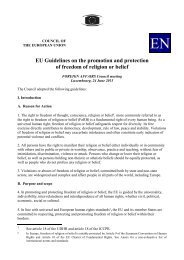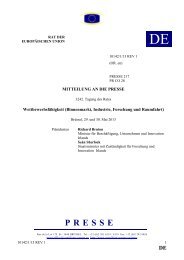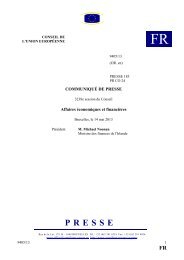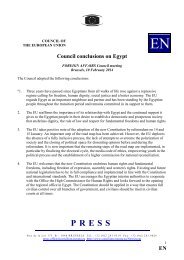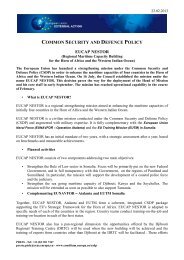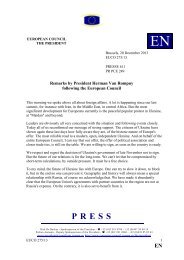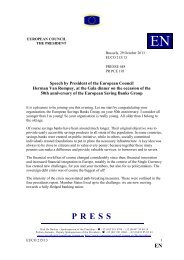14508/09 ADD 1 PL/vk 1 DG G COUNCIL OF THE ... - Europa
14508/09 ADD 1 PL/vk 1 DG G COUNCIL OF THE ... - Europa
14508/09 ADD 1 PL/vk 1 DG G COUNCIL OF THE ... - Europa
Create successful ePaper yourself
Turn your PDF publications into a flip-book with our unique Google optimized e-Paper software.
Without systematically gathered, comparable data on all forms of violence against women<br />
(domestic violence, sexual violence, stalking, forced marriage, trafficking), it becomes very difficult<br />
to explore the efficacy of the Member States' legal frameworks in addressing violence against<br />
women. When it is not possible to track cases across the criminal justice systems, it is difficult to<br />
assess whether any improvements in reporting and levels of prosecution have occurred.<br />
A positive sign was the creation of expert groups at EU level in order to develop indicators and data<br />
on violence against women, following the adoption by the European Commission of a<br />
communication on “Developing a comprehensive EU strategy to measure crime and criminal<br />
justice” 30 .<br />
4.4.4. Trends emphasised in Member States' reporting to the UNECE<br />
MS' reporting to the UNECE emphasises that violence against women remains an issue central to<br />
political agendas. Many MS aim at a more coordinated approach in tackling violence against<br />
women, and at least half have developed national strategies or plans of action on this issue.<br />
Continued development in policy and practice can be seen, especially when it comes to the<br />
criminalisation of violence and protection and support to victims. For example, many countries<br />
have now followed the innovative step taken by Austria in 1996 when legislation was introduced<br />
there allowing the police to take positive action at a domestic violence incident to exclude the<br />
perpetrator of violence from the home. With six more MS (BG, CZ, EL, HU, LU, <strong>PL</strong>, SK) reporting<br />
the introduction of similar measures in the period 2005-20<strong>09</strong>, the “order to go” can be considered a<br />
trend within the MS. 31<br />
30 Communication from the Commission to the European Parliament, the Council and the<br />
European Economic and Social Committee of 7 August 2006 – Developing a comprehensive<br />
and coherent EU strategy to measure crime and criminal justice: an EU Action Plan 2006-<br />
2010, COM (2006) 437 final<br />
31 In the Beijing +10 report, nine MS (not mentioned) reported such measures.<br />
<strong>14508</strong>/<strong>09</strong> <strong>ADD</strong> 1 <strong>PL</strong>/<strong>vk</strong> 72<br />
ANNEX <strong>DG</strong> G EN



